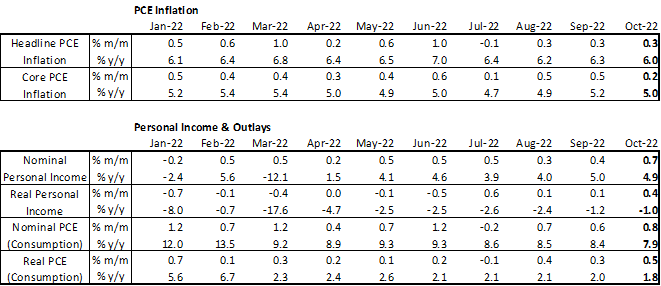-
Email
Linkedin
Facebook
Twitter
Copy Link

Loading...
October Personal Income & Outlays data showed more progress on inflation and a resilient consumer. While higher energy prices kept month-over-month PCE inflation flat at 0.3 percent, core PCE inflation dipped to 0.2 percent. Additionally, both headline and core PCE inflation dropped in year-over-year terms. While these rates remain far too high, it does appear that progress is being made. Personal incomes expanded in October, in both nominal and inflation-adjusted terms, as did personal consumption expenditures. These data will likely encourage the Fed to make a 50 basis point increase in the Fed Funds rate next week. Inflation: Headline PCE price inflation fell 0.3 percentage points to 6.0 percent y/y in October and core PCE price inflation (which excludes food and energy) fell 0.2 percentage points to 5.0 percent y/y. On a month-over-month basis headline PCE inflation rose by 0.3 percent again, but core PCE inflation fell from 0.5 percent to 0.2 percent. Energy prices were a major driver of inflation for the month. While these readings remain well above the Fed’s 2 percent y/y target, there appears to be real progress being made. Incomes: Overall personal income growth rose 0.7 percent m/m (in nominal terms), vs. 0.4 m/m percent in September. However, the increase was partially offset by rising prices. In inflation-adjusted terms, personal income rose 0.4 percent from September. While real personal income growth was consistently negative in the first half of 2022, wage gains have been outpacing price increases in recent months. Spending: Personal consumption expenditures rose by 0.8 percent m/m (in nominal terms) in October, vs. 0.6 m/m percent in September. Spending on services rose by 0.5 percent m/m while spending on goods rose 1.4 percent m/m. However, after accounting for inflation, real consumer spending rose by 0.5 percent m/m in October with spending on goods rising 1.1 percent m/m and spending of services rising 0.2 percent m/m. We expect personal consumption expenditure growth to slow over the coming months as tighter monetary policy drives interest rates higher. Note: nominal means non-inflation adjusted, while real means inflation adjusted.

Retail Sales Show Consumers Stock Up ahead of Tariffs
April 16, 2025
US Seeks Shipbuilding Revival, Muting of China Dominance
April 14, 2025
March CPI May Hint at Consumer Pullback as Tariffs Rise
April 10, 2025
The US-China Trade War Escalates
April 09, 2025
Reciprocal Tariffs Will Weaken US and Global Economies
April 03, 2025
Charts
Preliminary PMI indices show no change in weak DM growth momentum in November
LEARN MORECharts
Members of The Conference Board can access all underlying data of the Job Loss Risk Index by Industry in this Excel workbook.
LEARN MORECharts
While a US recession appears to be imminent, it will not look like any other in recent history.
LEARN MORECharts
CEOs’ views of current and future economic conditions remain pessimistic as they prepare for near-inevitable US and EU recessions.
LEARN MORECharts
The US economy appears to be on the precipice of recession.
LEARN MORECharts
Measure of CEO Confidence declined for the fifth consecutive quarter in Q3 2022 and has hit lows not seen since the start of the COVID-19 pandemic in 2020.
LEARN MOREPRESS RELEASE
US Leading Economic Index® (LEI) Fell in March
April 18, 2024
PRESS RELEASE
US Consumer Confidence Little Changed in March
March 26, 2024
PRESS RELEASE
US Leading Economic Index® (LEI) Inched Up in February
March 21, 2024
PRESS RELEASE
US Consumer Confidence Retreated in February
February 27, 2024
PRESS RELEASE
US Leading Economic Index® (LEI) Fell Further in January
February 20, 2024
PRESS RELEASE
CEO Confidence Improved in Q1 2024
February 08, 2024
